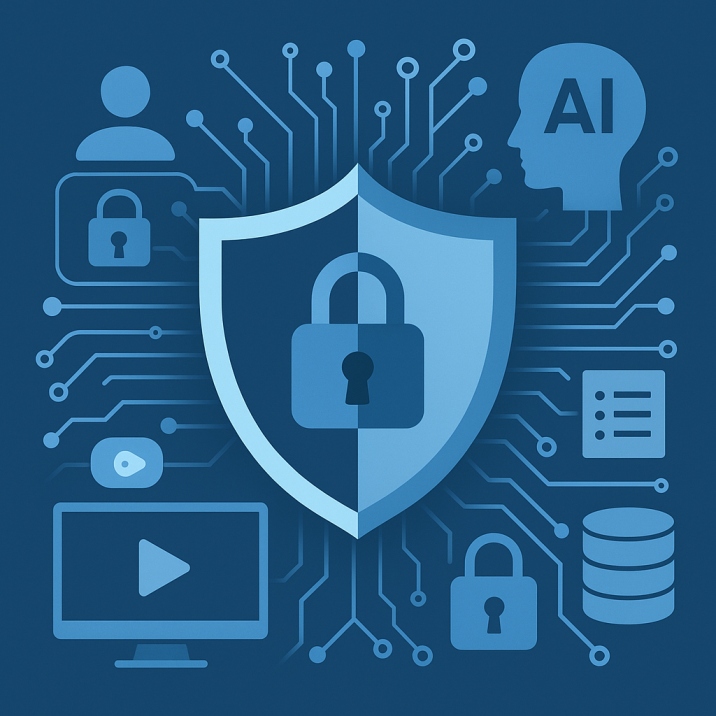Table of Contents
ToggleIs your video streaming security ready for 2025’s evolving threats? Discover how AI, encryption, and privacy-first strategies protect content, users, and your platform’s future.
Key Takeaways: Secure Streaming in 2025
AI Security Is a Must-Have, Not a Bonus: Traditional defenses can’t keep up—AI delivers real-time threat detection, dynamic watermarking, and adaptive protection that evolves with threats.
Layered Defense Is Non-Negotiable: Combine encryption, access control, and behavior analytics with proactive audits and multi-layered network safeguards for end-to-end platform security.
Privacy Isn’t Just Compliance—It’s a Trust Builder: Transparent, user-friendly data practices and privacy-by-design create a competitive advantage in an increasingly regulated landscape.
Security Starts With the User: Educating subscribers on best practices and implementing zero-trust access frameworks reduces vulnerabilities from the inside out.
Future-Proof Your Platform: Stay resilient by continuously adopting new tech, screening vendors, and preparing breach response plans—security isn’t a one-time setup, it’s a strategic evolution.
The 3 Foundational Safeguards for Secure Streaming
Every video streaming platform’s security rests on these critical pillars:
Encryption
Your primary shield that scrambles content, ensuring only authorized users with decryption keys can view it.TLS Encryption: Protects data in transit between devices and servers against interception
AES-256 Encryption: Secures stored data at rest from breaches
DRM Systems: Prevent illegal redistribution of videos (even after download)
Access Control
Granular permission systems include:Multi-factor authentication (MFA) for verified logins
Role-based access control (RBAC) defining precise viewing/editing rights
Data Protection Policies
GDPR/CCPA-compliant frameworks that:Govern user information handling
Enforce privacy preservation standards
Build legal and ethical trust
Together, these create an essential security baseline for any streaming operation.
AI Security for Video Streaming: Why It’s Non-Negotiable in 2025
Artificial Intelligence (AI) is revolutionizing video streaming security, offering unmatched protection for content and user privacy. As cyber threats evolve, traditional security falls short. AI delivers critical advantages:
Real-time threat detection that instantly identifies attacks
Automated defenses against sophisticated piracy attempts
Understanding AI-powered security is essential for all streaming professionals to build viewer trust and safeguard valuable content in today’s threat landscape.
5 Essential AI Security Features for Streaming Platforms
Real-Time Threat Detection
AI continuously monitors streaming traffic, instantly blocking threats like:Suspicious logins from multiple locations
Unusual bandwidth spikes
Unauthorized access attempts
AI-Powered Dynamic Watermarking
Invisible, unique digital fingerprints trace pirated content to its source, actively deterring leaks.Behavioral Analytics
Machine learning identifies abnormal user patterns like:Credential sharing rings
Botnet activity
Compromised accounts
Automated Encryption Key Rotation
AI manages encryption keys, regularly rotating them to prevent compromise without IT overhead.AI-Driven CDN Protection
Content Delivery Networks leverage AI to neutralize DDoS attacks and ensure secure, buffer-free streaming.
AI Security Benefits: Protecting Platforms & Viewers
Proactive Content Protection
AI prevents piracy and unauthorized sharing before content leaks cause revenue loss.Enhanced Privacy Compliance
Automatically enforces GDPR/CCPA by monitoring data access and usage patterns.Seamless Viewing Experience
Minimizes playback interruptions and false security blocks during streaming.Future-Proof Scalability
AI security adapts to evolving threats as your audience grows.
Data Protection: The Foundation of Streaming Privacy
Robust data protection policies govern how streaming platforms legally collect, store, and share viewer information. GDPR and CCPA compliance does more than avoid penalties—it builds essential viewer trust through:
Transparent data practices
User control over personal information
Treating privacy as a core value differentiates platforms in today’s competitive landscape.
8 Advanced Security Measures for Streaming Platforms
Proactive Security Audits
Regular vulnerability scans and compliance checks identify weaknesses before attackers do.Multi-Layered Network Defense
Combine firewalls, intrusion detection (IDS), and prevention systems (IPS) to shield infrastructure.Breach Response Planning
Prepare incident playbooks for rapid threat containment and damage control.Subscriber Security Education
Teach users to recognize phishing and practice password hygiene.Privacy by Design Implementation
Bake data protection into every new feature during development.Anti-Piracy Content Protection
Deploy forensic watermarking to trace leaks and deter piracy.Third-Party Vendor Screening
Audit all data processors and enforce ironclad security contracts.Zero-Trust Access Framework
Authenticate every device and user before granting platform access.
The Transparency Imperative
Meet rising viewer expectations with:
One-click opt-outs from data collection
Instant access to personal data profiles
Simple content deletion tools
Proactive transparency turns compliance into competitive advantage.
Critical Streaming Security Challenges (2025)
Expanding Attack Surfaces
Sophisticated threats target complex systems managing massive viewer data.Evolving Regulatory Maze
Keeping pace with global privacy law changes strains resources.The Personalization-Privacy Paradox
AI-driven customization demands more data collection—heightening privacy risks.
Your Action Plan for 2025
Protect what matters most:
Users: Deploy end-to-end encryption and granular access controls
Content: Implement AI-powered anti-piracy solutions
Reputation: Enforce transparent data policies
Stay ahead through:
Continuous security tech adoption
Proactive threat hunting via audits
Subscriber security awareness programs
Balance innovation with trust:
Ethical AI personalization within clear boundaries
Comprehensive privacy-by-design frameworks
Build viewer loyalty by making security your competitive edge.
As streaming threats grow more sophisticated, staying secure in 2025 demands more than just basic protection. By combining AI-powered defenses, airtight encryption, and privacy-by-design practices, you not only safeguard your platform—but you build lasting viewer trust.
Ready to elevate your streaming security?
Start implementing these strategies today to future-proof your platform, protect your content, and keep your audience coming back with confidence.
FAQs
What are the best security measures for video streaming platforms?
Use AES-256 encryption for data protection.
Implement multi-factor authentication (MFA).
Apply Digital Rights Management (DRM) to prevent piracy.
Enforce access controls like geo-restrictions and role-based permissions.
How does encryption protect video streaming content?
Encryption scrambles video data so only authorized users with keys can view it, preventing hackers from intercepting or stealing content during transmission or storage.
Why is multi-factor authentication important for streaming security?
MFA adds extra verification steps beyond passwords, making it harder for unauthorized users to access accounts even if passwords are compromised.
How can video streaming platforms ensure user privacy compliance?
By following regulations like GDPR and CCPA, using transparent data policies, minimizing data collection, and offering users control over their personal information.
What role does AI play in video streaming security?
AI detects unusual access patterns and threats in real time, automates encryption key management, and helps prevent piracy with intelligent watermarking.
How do geo-restrictions enhance video streaming security?
Geo-restrictions limit video access to specific countries or IP ranges, blocking unauthorized viewers from regions where content shouldn’t be available.
What should I do if my streaming platform experiences a security breach?
Immediately isolate affected systems, notify users transparently, investigate the breach, patch vulnerabilities, and review your incident response plan.
How does Digital Rights Management (DRM) protect streaming videos?
DRM restricts copying and sharing by encrypting content and controlling playback to authorized devices only.
Can password protection alone secure live video streams?
Password protection helps but should be combined with encryption and MFA for stronger security.
What are the risks of using third-party vendors in streaming security?
Third parties can introduce vulnerabilities if not properly vetted, risking data leaks or unauthorized access.
How do streaming platforms monitor for security threats?
They use continuous monitoring tools, AI analytics, and audit logs to detect and respond to suspicious activity.
What is Privacy by Design in video streaming?
It means integrating privacy protections into every feature and process from the start, ensuring user data is safeguarded by default.



